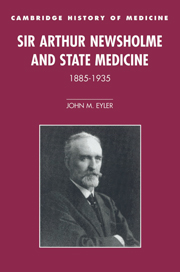Book contents
- Frontmatter
- Contents
- Illustrations
- Preface
- Abbreviations
- PART I THE MEDICAL OFFICER OF HEALTH AND THE LOCAL SANITARY AUTHORITY
- PART II NEWSHOLME AT THE LOCAL GOVERNMENT BOARD
- 7 Poverty, fitness, and the Poor Law
- 8 The Local Government Board and the nation's health policy
- 9 Launching a national tuberculosis program
- 10 The Great War and the public health enterprise
- 11 Infant and maternal mortality, interdepartmental conflict, and Newsholme supplanted
- PART III THE OLD WORLD AND THE NEW: NEWSHOLME AS ELDER STATESMAN
- Select bibliography
- Index
- Titles in the series
11 - Infant and maternal mortality, interdepartmental conflict, and Newsholme supplanted
Published online by Cambridge University Press: 04 December 2009
- Frontmatter
- Contents
- Illustrations
- Preface
- Abbreviations
- PART I THE MEDICAL OFFICER OF HEALTH AND THE LOCAL SANITARY AUTHORITY
- PART II NEWSHOLME AT THE LOCAL GOVERNMENT BOARD
- 7 Poverty, fitness, and the Poor Law
- 8 The Local Government Board and the nation's health policy
- 9 Launching a national tuberculosis program
- 10 The Great War and the public health enterprise
- 11 Infant and maternal mortality, interdepartmental conflict, and Newsholme supplanted
- PART III THE OLD WORLD AND THE NEW: NEWSHOLME AS ELDER STATESMAN
- Select bibliography
- Index
- Titles in the series
Summary
WHY MOTHERS AND BABIES DIE
In the years between 1910 and 1916 Newsholme published five book-length official reports on infant, childhood, and maternal mortality. Collectively these reports represented the most intensive empirical studies of these subjects to date in English. They should be understood historically as part of an ongoing debate about the meaning of death among the very young that took new form with the investigations of national efficiency and physical fitness following the Boer War. As such, these reports had immediate policy intentions. Newsholme was intent not only on demonstrating that recent national initiatives, undertaken in the wake of the Boer War, to promote the health of schoolchildren through school meals, medical examination, and medical treatment should be extended to children of preschool ages, but also on answering eugenists who warned that such ameliorative efforts merely hastened the pace of the nation's physical and mental degeneration.
Newsholme's investigations may have been the most extensive, but they were not the first. Studies of infant mortality had become more common in M.O.H. reports and in medical journals, and several other monographs on infant mortality had appeared in the decade preceding 1916. The General Register Office had taken the lead by drawing attention to the problem long before the Boer War, providing the basic data and a tradition of analysis for these investigations. John Tatham, successor to William Farr and William Ogle at the G.R.O., took a special interest in infant mortality and applied to the problem the sorts of statistical and demographic analyses Farr had pioneered.
- Type
- Chapter
- Information
- Sir Arthur Newsholme and State Medicine, 1885–1935 , pp. 295 - 338Publisher: Cambridge University PressPrint publication year: 1997

